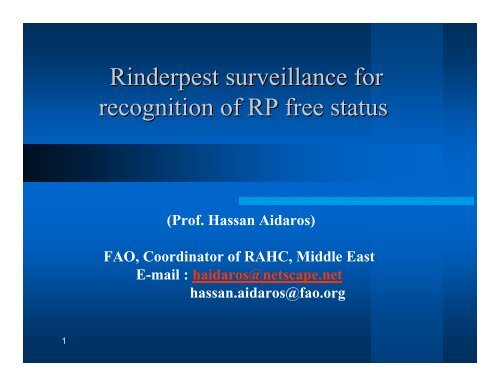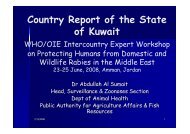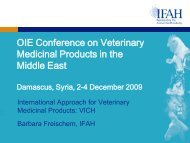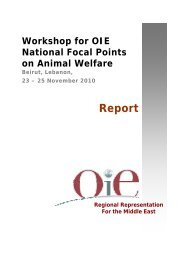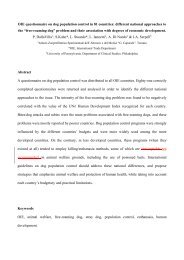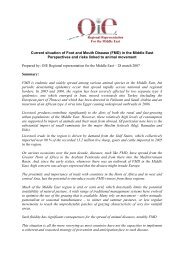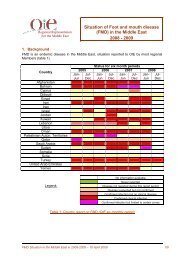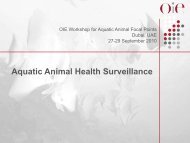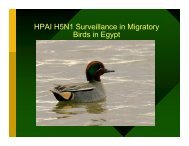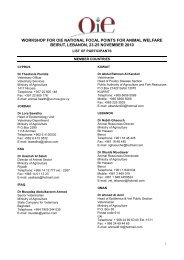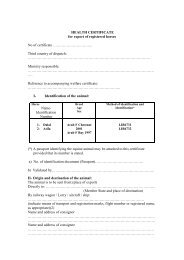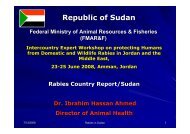Rinderpest surveillance for recognition of RP free ... - Middle East - OIE
Rinderpest surveillance for recognition of RP free ... - Middle East - OIE
Rinderpest surveillance for recognition of RP free ... - Middle East - OIE
You also want an ePaper? Increase the reach of your titles
YUMPU automatically turns print PDFs into web optimized ePapers that Google loves.
<strong>Rinderpest</strong> <strong>surveillance</strong> <strong>for</strong><br />
<strong>recognition</strong> <strong>of</strong> <strong>RP</strong> <strong>free</strong> status<br />
(Pr<strong>of</strong>. Hassan Aidaros)<br />
FAO, Coordinator <strong>of</strong> RAHC, <strong>Middle</strong> <strong>East</strong><br />
E-mail : haidaros@netscape.net<br />
hassan.aidaros@fao.org<br />
1
Introduction<br />
<br />
<br />
Historically, the virus was widely distributed throughout Europe,<br />
Africa, and Asia; recently however, it has only occurred in Africa<br />
and Asia. Gene sequence analysis has shown that all known<br />
rinderpest isolates fall into one <strong>of</strong> three non-overlapping<br />
phylogenetic lineages, and in recent years it has been possible<br />
to describe the virus' distribution in lineage-specific terms.<br />
Thus, the so-called Asian lineage (lineage 3) was only ever<br />
recorded in Afghanistan, India, Iran, Iraq, Kuwait, Oman,<br />
Pakistan, Russia, Saudi Arabia, Turkey, Sri Lanka and Yemen.<br />
As a result <strong>of</strong> concerted and coordinated vaccination and<br />
<strong>surveillance</strong> campaigns, this virus lineage has failed to resurface<br />
since September 2000 (Pakistan). Although evaluations are not<br />
yet complete, it is almost certain that this virus has been<br />
successfully eradicated.<br />
2
Introduction (cont.)<br />
<br />
<br />
3<br />
<strong>Rinderpest</strong> virus lineages 1 and 2 have only been recorded from<br />
Africa. Lineage 1 appears to have been distributed from Egypt<br />
to southern Sudan and eastwards into Ethiopia and into<br />
northern and western Kenya. On the other hand, lineage 2 has<br />
been recorded from both <strong>East</strong> and West Africa and at one time<br />
may have been distributed in a sub-Saharan belt running across<br />
the whole <strong>of</strong> the continent.<br />
Now however, as the result <strong>of</strong> further coordinated vaccination<br />
and <strong>surveillance</strong> programmes (Pan African <strong>Rinderpest</strong><br />
Campaign in particular), neither West nor Central Africa have<br />
reported rinderpest <strong>for</strong> the past 15 years. Until recently both<br />
lineages were being reported from eastern Africa (lineage 1 in<br />
southern Sudan in 1998 and lineage 2 in Kenya in 2001). The<br />
failure to find more recent evidence that lineage 1 is still being<br />
transmitted supports the belief that this lineage has also been<br />
eradicated.
GENERAL GUIDELINES FOR<br />
ANIMAL HEALTH<br />
SURVEILLANCE<br />
4
Principles <strong>of</strong> <strong>surveillance</strong><br />
1) Types <strong>of</strong> <strong>surveillance</strong><br />
Surveillance may be based on many different<br />
data sources and can be classified in a number<br />
<strong>of</strong> ways, including:<br />
– the means by which data are collected (active versus<br />
passive <strong>surveillance</strong>);<br />
– the disease focus (pathogen-specific versus general<br />
<strong>surveillance</strong>); and<br />
– the way in which units <strong>for</strong> observation are selected<br />
(structured surveys versus non-random data<br />
sources).<br />
5
Principles <strong>of</strong> <strong>surveillance</strong> (cont.)<br />
<br />
<strong>surveillance</strong> activities are classified as being based on:<br />
EITHER<br />
structured population-based surveys, such as:<br />
• systematic sampling at slaughter;<br />
• random surveys;<br />
OR<br />
structured non-random <strong>surveillance</strong> activities, such as:<br />
• disease reporting or notifications;<br />
• control programmes/health schemes;<br />
• targeted testing/screening;<br />
• ante-mortem and post-mortem inspections;<br />
• laboratory investigation records;<br />
• biological specimen banks;<br />
• sentinel units;<br />
• field observations;<br />
• farm production records.<br />
6
Principles <strong>of</strong> <strong>surveillance</strong> (cont.)<br />
<br />
In addition, <strong>surveillance</strong> data should be<br />
supported by related in<strong>for</strong>mation, such as:<br />
– data on the epidemiology <strong>of</strong> the infection, including<br />
environmental, host population distribution, and<br />
climatic in<strong>for</strong>mation;<br />
– data on animal movements and trading patterns <strong>for</strong><br />
animals and animal products;<br />
– national animal health regulations, including<br />
in<strong>for</strong>mation on compliance with them and their<br />
effectiveness;<br />
– history <strong>of</strong> imports <strong>of</strong> potentially infected material; and<br />
– biosecurity measures in place.<br />
7
Principles <strong>of</strong> <strong>surveillance</strong> (cont.)<br />
<br />
8<br />
The sources <strong>of</strong> evidence should be fully<br />
described. In the case <strong>of</strong> a structured<br />
survey, this should include a description<br />
<strong>of</strong> the sampling strategy used <strong>for</strong> the<br />
selection <strong>of</strong> units <strong>for</strong> testing. For<br />
structured non-random data sources, a<br />
full description <strong>of</strong> the system is required<br />
including the source(s) <strong>of</strong> the data, when<br />
the data were collected, and a<br />
consideration <strong>of</strong> any biases that may be<br />
inherent in the system.
Principles <strong>of</strong> <strong>surveillance</strong> (cont.)<br />
2 ) Critical elements<br />
<br />
In assessing the quality <strong>of</strong> a <strong>surveillance</strong> system, the<br />
following critical elements need to be addressed over<br />
and above quality <strong>of</strong> Veterinary Services:<br />
– Populations<br />
– Epidemiological unit<br />
– Clustering<br />
– Case and outbreak definitions<br />
– Analytical methodologies<br />
– Testing<br />
– Quality assurance<br />
– Validation<br />
– Data collection and management<br />
9
Structured population-based surveys:<br />
– In addition to the principles <strong>for</strong> <strong>surveillance</strong><br />
discussed above, the following guidelines<br />
should be used when planning,<br />
implementing and analyzing surveys.<br />
• Types <strong>of</strong> surveys<br />
• Survey design<br />
• Sampling<br />
• Sampling methods<br />
• Sample size<br />
10
Structured non-random <strong>surveillance</strong><br />
<br />
Surveillance systems routinely use structured<br />
non-random data, either alone or in combination<br />
with surveys.<br />
1) Common non-random <strong>surveillance</strong> sources:<br />
a) Disease reporting or notification systems<br />
b) Control programmes / health schemes<br />
c) Targeted testing / screening<br />
d) Ante-mortem and post-mortem inspections<br />
e) Laboratory investigation records<br />
f) Biological specimen banks<br />
g) Sentinel units<br />
h) Field observations<br />
i) Farm production records<br />
11
Structured non-random <strong>surveillance</strong><br />
(cont.):<br />
2) Critical elements <strong>for</strong> structured<br />
non-random <strong>surveillance</strong><br />
3) Analytical methodologies<br />
4) Combination <strong>of</strong> multiple sources<br />
<strong>of</strong> data<br />
12
Surveillance to demonstrate <strong>free</strong>dom<br />
from disease/infection<br />
1. Requirements to declare a country, zone or<br />
compartment <strong>free</strong> from disease/infection without<br />
pathogen specific <strong>surveillance</strong>:<br />
1. Historically <strong>free</strong><br />
2. Last occurrence within the previous 25 years<br />
2. Guidelines <strong>for</strong> the discontinuation <strong>of</strong> pathogenspecific<br />
screening after <strong>recognition</strong> <strong>of</strong> <strong>free</strong>dom<br />
from infection<br />
3. International <strong>recognition</strong> <strong>of</strong> disease/infection <strong>free</strong><br />
status<br />
4. Demonstration <strong>of</strong> <strong>free</strong>dom from infection<br />
13
Surveillance <strong>for</strong> distribution and<br />
occurrence <strong>of</strong> infection<br />
Surveillance to determine distribution and occurrence <strong>of</strong><br />
infection or <strong>of</strong> other relevant health related events is widely<br />
used to assess progress in the control or eradication <strong>of</strong><br />
selected diseases and pathogens and as an aid to decision<br />
making. It has, however, relevance <strong>for</strong> the international<br />
movement <strong>of</strong> animals and products when movement occurs<br />
among infected countries.<br />
In contrast to <strong>surveillance</strong> to demonstrate <strong>free</strong>dom from<br />
infection, <strong>surveillance</strong> used to assess progress in control or<br />
eradication <strong>of</strong> selected diseases and pathogens is usually<br />
designed to collect data about a number <strong>of</strong> variables <strong>of</strong> animal<br />
health relevance, <strong>for</strong> example:<br />
– prevalence or incidence <strong>of</strong> infection;<br />
– morbidity and mortality rates;<br />
– frequency <strong>of</strong> disease/infection risk factors and their<br />
quantification;<br />
14
GUIDELINES FOR THE<br />
SURVEILLANCE OF<br />
RINDE<strong>RP</strong>EST<br />
15
<strong>OIE</strong> GUIDELINES FOR THE SURVEILLANCE<br />
OF RINDE<strong>RP</strong>EST<br />
<strong>Rinderpest</strong> must be a notifiable disease i.e. notification<br />
<strong>of</strong> outbreaks <strong>of</strong> rinderpest as soon as detected or<br />
suspected must be brought to the attention <strong>of</strong> the<br />
Veterinary Authority.<br />
The precise <strong>surveillance</strong> in<strong>for</strong>mation required <strong>for</strong><br />
establishing <strong>free</strong>dom will differ from country to country<br />
depending on factors such as the <strong>for</strong>mer rinderpest<br />
status <strong>of</strong> the country, the regional rinderpest situation<br />
and accreditation status, the time elapsing since the<br />
last occurrence <strong>of</strong> rinderpest, livestock husbandry<br />
systems (e.g. extensive pastoralism, nomadism and<br />
transhumance versus sedentary agropastoralism) and<br />
trading patterns.<br />
16
Surveillance results presented will be expected to have accrued from<br />
a combination <strong>of</strong> <strong>surveillance</strong> activities including some or all <strong>of</strong> the<br />
following:<br />
1. A routine national animal disease reporting system<br />
supported by evidence <strong>of</strong> its efficiency and follow-up - an<br />
on-going, statutory, centrally organized system <strong>of</strong> reporting<br />
Ideally disease reports should be expressed in a<br />
Geographical In<strong>for</strong>mation System environment and analyzed<br />
<strong>for</strong> clustering <strong>of</strong> observations and followed up.<br />
2. Emergency disease reporting systems and investigation <strong>of</strong><br />
epidemiologically significant events (‘stomatitis-enteritis<br />
syndrome’) Emergency reporting systems can be devised to<br />
short-circuit normal passive reporting systems to bring<br />
suspicious events to the <strong>for</strong>e and lead to rapid investigation<br />
and tracing. All such investigations should be well<br />
documented <strong>for</strong> presentation as an outcome <strong>of</strong> the<br />
<strong>surveillance</strong> system.<br />
17
Surveillance results presented will be expected to have accrued<br />
from a combination <strong>of</strong> <strong>surveillance</strong> activities including some or<br />
all <strong>of</strong> the following:<br />
3. Detection and thorough investigation <strong>of</strong> epidemiologically<br />
significant events (‘stomatitis-enteritis syndrome’) which<br />
raise suspicion <strong>of</strong> rinderpest supported by evidence <strong>of</strong><br />
efficiency <strong>of</strong> the system Laboratory examination<br />
undertaken to confirm or rule out rinderpest is given extra<br />
credibility if it is accompanied by the results <strong>of</strong> differential<br />
diagnostic examinations.<br />
4. Searching <strong>for</strong> evidence <strong>of</strong> clinical rinderpest Active search<br />
<strong>for</strong> disease might include participatory disease searching<br />
combined with village disease searching, tracing<br />
backwards and <strong>for</strong>wards, follow-up and investigation.<br />
18
Surveillance results presented will be expected to have accrued<br />
from a combination <strong>of</strong> <strong>surveillance</strong> activities including some or<br />
all <strong>of</strong> the following:<br />
5) Sero<strong>surveillance</strong>:<br />
a) Randomized sero-surveys<br />
b) Risk-focused sero-<strong>surveillance</strong><br />
19
a) Randomized serosurveys<br />
<br />
<br />
<br />
<br />
<br />
Statistically selected samples from relevant strata within the host<br />
populations are examined to detect serological evidence <strong>of</strong><br />
possible virus circulation.<br />
A sampling unit is defined as a group <strong>of</strong> animals in sufficiently<br />
close contact that individuals within the group are at<br />
approximately equal risk <strong>of</strong> coming in contact with the virus if<br />
there should be an infectious animal within the group.<br />
In most circumstances, the sampling unit will be a herd which is<br />
managed as a unit by an individual or a community,<br />
But it may also be other epidemiologically appropriate groupings<br />
which are subject to regular mixing, such as all animals belonging<br />
to residents <strong>of</strong> a village.<br />
Nomadic or transhumant movements exist, the sampling unit can<br />
be the permanent bore holes, wells or water points. Sampling<br />
units should normally be defined so that their size is generally<br />
between 50 and 1,000 animals.<br />
20
a) Randomized sero-surveys surveys (cont.)<br />
Criteria <strong>for</strong> stratification <strong>of</strong> host populations<br />
Strata are homogeneously mixing subpopulations<br />
<strong>of</strong> livestock. Any disease<br />
<strong>surveillance</strong> activities must be conducted on<br />
populations stratified according to the<br />
management system, and by herd size where<br />
this is variable. Herds, or other sampling units,<br />
should be selected by proper random<br />
statistical selection procedures from each<br />
stratum.<br />
21
a) Randomized sero-surveys surveys (cont.)<br />
Field procedures and sample<br />
sizes<br />
1) Annual sample sizes shall be sufficient to provide 95%<br />
probability <strong>of</strong> detecting evidence <strong>of</strong> rinderpest if present at a<br />
prevalence <strong>of</strong> 1% <strong>of</strong> herds or other sampling units and 5%<br />
within herds or other sampling units. This can typically be<br />
achieved by examining 300 herds per stratum per year, but<br />
procedures <strong>for</strong> sampling should be in accordance with the<br />
“Guide to Epidemiological Surveillance <strong>for</strong> <strong>Rinderpest</strong>”, or<br />
another procedure that would achieve the same probability <strong>of</strong><br />
detection.<br />
22
a) Randomized sero-surveys surveys (cont.):<br />
Field procedures and sample sizes (cont.)<br />
2) Where the sampling frame <strong>of</strong> herds is known,<br />
herds shall be selected <strong>for</strong> examination by the use<br />
<strong>of</strong> random number tables. Otherwise, samples <strong>of</strong><br />
herds can be selected by taking the nearest herd to<br />
a randomly selected map reference, provided that<br />
the herds are evenly distributed. Failing this, any<br />
herd(s) within a fixed radius <strong>of</strong> randomly selected<br />
map references should be sampled. It must be<br />
compulsory <strong>for</strong> any selected herd to be examined<br />
or tested as required.<br />
23
a) Randomized sero-surveys surveys (cont.):<br />
Field procedures and sample sizes (cont.)<br />
3) In carrying out clinical <strong>surveillance</strong> <strong>for</strong> evidence <strong>of</strong> rinderpest, all<br />
animals in selected herds or sampling units will be examined by a<br />
veterinarian <strong>for</strong> signs <strong>of</strong> the disease, especially mouth lesions. Any<br />
positive result shall be evaluated using epidemiological and<br />
laboratory methods to confirm or refute the suspicion <strong>of</strong> rinderpest<br />
virus activity. All animals born after the cessation <strong>of</strong> vaccination and<br />
more than one year old will be eligible <strong>for</strong> serological testing.<br />
4) Where operational considerations require it, the number <strong>of</strong> eligible<br />
animals tested within each sampled herd may be reduced. This will<br />
reduce the probability <strong>of</strong> within-herd detection and there must be at<br />
least a compensatory increase in the number <strong>of</strong> herds sampled, so<br />
that the required 95% probability <strong>of</strong> detecting 1% between-herd<br />
prevalence is maintained.<br />
24
) Risk-focused sero-<strong>surveillance</strong><br />
<strong>surveillance</strong><br />
Risk-focussed sero<strong>surveillance</strong> differs from<br />
randomised sero<strong>surveillance</strong> in that it increases<br />
detection sensitivity by obtaining samples from<br />
areas/populations determined to be at higher risk <strong>of</strong><br />
infection, so as to detect serological evidence <strong>of</strong><br />
possible virus circulation. The operational<br />
modalities <strong>for</strong> risk-based focussing <strong>of</strong> <strong>surveillance</strong><br />
require definition (randomisation within defined<br />
focus, high risk animals, etc.). The extent to which<br />
randomisation needs to be retained in the<br />
generation <strong>of</strong> risk-focussed sero<strong>surveillance</strong> data<br />
needs to be established.<br />
25
) Risk-focused sero-<strong>surveillance</strong> <strong>surveillance</strong> (cont.)<br />
Focusing can be achieved by reference to some<br />
or all <strong>of</strong> the following:<br />
– Historical disease patterns (prior probability<br />
mapping) – clinical, participatory and laboratorybased<br />
– Critical population size, structure and density<br />
– Livestock husbandry and farming systems<br />
– Movement and contact patterns – markets and other<br />
trade-related movements<br />
– Transmission parameters (e.g. virulence <strong>of</strong> the<br />
strain, animal movements)<br />
– Wildlife and other species demography.<br />
26
Selection <strong>of</strong> cattle and buffaloes <strong>for</strong><br />
sero<strong>surveillance</strong><br />
<br />
Ageing cattle and Asian buffaloes <strong>for</strong> the<br />
purpose <strong>of</strong> sero<strong>surveillance</strong>:<br />
Mis-ageing <strong>of</strong> cattle selected <strong>for</strong> sero<strong>surveillance</strong> is the most<br />
common source <strong>of</strong> error. Colostral immunity can persist almost up<br />
to one year <strong>of</strong> age when measured by the H c-ELISA. Thus, it is<br />
essential to exclude from sampling buffaloes and cattle less than<br />
one year <strong>of</strong> age. In addition, it is frequently necessary to be able to<br />
exclude those which are older than a certain age, <strong>for</strong> example, to<br />
select only those born after cessation <strong>of</strong> vaccination.<br />
<br />
Accounts <strong>of</strong> the ages <strong>for</strong> eruption <strong>of</strong> the incisor teeth vary<br />
markedly and are clearly dependent on species, breed, nutritional<br />
status and nature <strong>of</strong> the feed.<br />
27
Selection <strong>of</strong> cattle and buffaloes <strong>for</strong><br />
sero<strong>surveillance</strong> (cont.)<br />
Pragmatically, and solely <strong>for</strong> the purposes <strong>of</strong><br />
sero<strong>surveillance</strong>, it can be accepted that:<br />
– cattle having only one pair <strong>of</strong> erupted permanent<br />
central incisor teeth are aged between 21 and<br />
36 months (Asian buffaloes 24-48 months);<br />
– cattle having only two pairs <strong>of</strong> erupted permanent<br />
central incisor teeth are aged between 30 and<br />
48 months (Asian buffaloes 48-60 months).<br />
– Thus selecting a cohort <strong>of</strong> cattle possessing only<br />
one pair <strong>of</strong> permanent incisors will preclude any<br />
interference from maternal immunity derived from<br />
earlier vaccination or infection and ensure that<br />
vaccinated cattle are not included if vaccination<br />
ceased 3 years or more previously (<strong>for</strong> Asian<br />
buffaloes 4 years or more).<br />
28
Selection <strong>of</strong> cattle and buffaloes <strong>for</strong><br />
sero<strong>surveillance</strong> (cont.)<br />
Although it is stressed here that animals with<br />
milk teeth only are not suitable <strong>for</strong> <strong>surveillance</strong><br />
based on serology, they are <strong>of</strong> particular interest<br />
and importance in <strong>surveillance</strong> <strong>for</strong> clinical<br />
disease. After the loss <strong>of</strong> colostral immunity, by<br />
about one year <strong>of</strong> age, these are the animals<br />
which are most likely to suffer the more severe<br />
disease <strong>for</strong>m and in which to look <strong>for</strong> lesions<br />
indicative <strong>of</strong> rinderpest.<br />
29
Wildlife <strong>surveillance</strong> where a significant<br />
susceptible wildlife population exists<br />
The standards <strong>for</strong> sero<strong>surveillance</strong> are different from<br />
that set <strong>for</strong> cattle because the serological tests are not<br />
fully validated <strong>for</strong> wildlife species and financial and<br />
logistic constraints <strong>of</strong> sampling prevent collection <strong>of</strong><br />
large numbers <strong>of</strong> samples.<br />
From the collective experience <strong>of</strong> the laboratories and<br />
experts over the years, an appropriate test protocol is<br />
based on the high expected sero-prevalence in a<br />
previously infected buffalo herd (99% seroconversion<br />
<strong>of</strong> eligible animals within a herd), which is detected<br />
using a test, which is 100% sensitive. No single test<br />
can achieve this; however, combining H c-ELISA to<br />
VNT raises sensitivity close to 100%.<br />
30
Evaluation <strong>of</strong> applications <strong>for</strong> accreditation <strong>of</strong><br />
<strong>free</strong>dom from rinderpest<br />
Evaluation <strong>of</strong> applications <strong>for</strong> the status <strong>of</strong> <strong>free</strong>dom<br />
from rinderpest will be the responsibility <strong>of</strong> the <strong>OIE</strong><br />
Scientific Commission <strong>for</strong> Animal Diseases which can<br />
request the Director General if the <strong>OIE</strong> to appoint an ad<br />
hoc group in order to assist in reaching an in<strong>for</strong>med<br />
decision to present to the <strong>OIE</strong> International Committee<br />
<strong>for</strong> approval.<br />
The composition and method <strong>of</strong> selection <strong>of</strong> the ad hoc<br />
group shall be such as to ensure both a high level <strong>of</strong><br />
expertise in evaluating the evidence and total<br />
independence <strong>of</strong> the group in reaching conclusions<br />
concerning the disease status <strong>of</strong> a particular country<br />
31
Steps<br />
to be taken to declare a country to be<br />
<strong>free</strong> from <strong>RP</strong><br />
32
Steps to be taken to declare a country to be<br />
<strong>free</strong> from rinderpest<br />
Be<strong>for</strong>e accreditation can be considered,<br />
countries which have controlled the<br />
disease by the use <strong>of</strong> rinderpest vaccine<br />
must wait until an unvaccinated cohort<br />
is available to allow meaningful<br />
serological <strong>surveillance</strong> to be<br />
conducted.<br />
33
Steps to be taken to declare a country to be<br />
<strong>free</strong> from rinderpest (cont.)<br />
The <strong>OIE</strong> has concluded that the majority <strong>of</strong> countries<br />
have stopped vaccinating <strong>for</strong> a sufficient length <strong>of</strong><br />
time <strong>for</strong> it now to be feasible that a single submission<br />
<strong>of</strong> evidence gained over 2 years <strong>of</strong> appropriate<br />
<strong>surveillance</strong> shall be sufficient to gain rinderpest <strong>free</strong><br />
accreditation.<br />
A Member Country accredited as <strong>free</strong> from rinderpest<br />
must thereafter submit annual statements to the<br />
Director General <strong>of</strong> the <strong>OIE</strong> indicating that<br />
<strong>surveillance</strong> has failed to disclose the presence <strong>of</strong><br />
rinderpest, and that all other criteria continue to be<br />
met.<br />
34
Steps to be taken to declare a country to be<br />
<strong>free</strong> from rinderpest (cont.)<br />
<br />
A country previously infected with rinderpest which has not<br />
employed rinderpest vaccine <strong>for</strong> at least 25 years and has<br />
throughout that period detected no evidence <strong>of</strong> rinderpest virus<br />
disease or infection may be accredited as <strong>free</strong> from rinderpest by<br />
the <strong>OIE</strong> based on historical grounds, provided that the country<br />
35<br />
• has had throughout at least the last 10 years and<br />
maintains permanently an adequate animal disease<br />
<strong>surveillance</strong> system along with the other requirements<br />
outlined in Article 3.8.1.6.(Surveillance to demonstrate<br />
<strong>free</strong>dom from disease/infection ).<br />
• is in compliance with <strong>OIE</strong> reporting obligations<br />
chapter 1.1.2. (Chapter <strong>for</strong> Notification <strong>of</strong> diseases and<br />
epidemiological in<strong>for</strong>mation )
Steps to be taken to declare a country<br />
to be <strong>free</strong> from rinderpest (cont.)<br />
The Veterinary Authorities <strong>of</strong> the Member<br />
Country must submit a dossier containing<br />
evidence supporting their claim to be <strong>free</strong><br />
from rinderpest on a historical basis to the<br />
Director General <strong>of</strong> the <strong>OIE</strong> <strong>for</strong> evaluation<br />
by the <strong>OIE</strong> Scientific Commission <strong>for</strong><br />
Animal Diseases and accreditation by the<br />
<strong>OIE</strong> International Committee. The dossier<br />
should contain at least the following<br />
in<strong>for</strong>mation:<br />
36
Steps to be taken to declare a country<br />
to be <strong>free</strong> from rinderpest (cont.)<br />
<br />
<br />
<br />
<br />
<br />
<br />
a description <strong>of</strong> livestock populations, including wildlife;<br />
the history <strong>of</strong> rinderpest occurrence in the country and its control;<br />
an affirmation that rinderpest has not occurred <strong>for</strong> 25 years, that<br />
vaccine has not been used during that time, and that rinderpest is<br />
a notifiable disease;<br />
evidence that in the last 10 years the disease situation throughout<br />
the Member Country has been constantly monitored by a<br />
competent and effective veterinary infrastructure that has<br />
operated a national animal disease reporting system submitting<br />
regular (monthly) disease occurrence reports to the Veterinary<br />
Authority;<br />
the structure and functioning <strong>of</strong> the Veterinary Services;<br />
the Member Country operates a reliable system <strong>of</strong> risk analysis<br />
based importation <strong>of</strong> livestock and livestock products.<br />
37
Steps to be taken to declare a country<br />
to be <strong>free</strong> from rinderpest (cont.)<br />
Evidence in support <strong>of</strong> these criteria must<br />
accompany the Member Country’s<br />
accreditation application dossier. In the event<br />
that satisfactory evidence is not <strong>for</strong>thcoming,<br />
the <strong>OIE</strong> may seek clarification or refer the<br />
dossier back to the originators, giving its<br />
reasons <strong>for</strong> so doing. Under such<br />
circumstances a fresh dossier would be<br />
entertained in due course.<br />
OR<br />
38
Steps to be taken to declare a country to be<br />
<strong>free</strong> from rinderpest (cont.)<br />
<br />
<br />
Member Country having eradicated rinderpest within the last<br />
25 years, wishing to be accredited <strong>free</strong> from rinderpest and having<br />
ended rinderpest vaccination must initiate a two-year <strong>surveillance</strong><br />
programme to demonstrate <strong>free</strong>dom from rinderpest whilst<br />
banning further use <strong>of</strong> rinderpest vaccine. The step <strong>of</strong><br />
accreditation as <strong>free</strong> from rinderpest is subject to meeting<br />
stringent criteria with international verification under the auspices<br />
<strong>of</strong> the <strong>OIE</strong>.<br />
A country historically infected with rinderpest but which has<br />
convincing evidence that the disease has been excluded <strong>for</strong> at<br />
least two years and is not likely to return, may apply to <strong>OIE</strong> to be<br />
accredited as <strong>free</strong> from rinderpest. The conditions which apply<br />
include that an adequate animal disease <strong>surveillance</strong> system has<br />
been maintained throughout at least that period.<br />
39
Steps to be taken to declare a country to be<br />
<strong>free</strong> from rinderpest (cont.)<br />
The Veterinary Authority <strong>of</strong> the Member Country must<br />
submit a dossier containing evidence supporting their<br />
claim to be <strong>free</strong> from rinderpest to the Director General<br />
<strong>of</strong> the <strong>OIE</strong> <strong>for</strong> evaluation by the <strong>OIE</strong> Scientific<br />
Commission <strong>for</strong> Animal Diseases and accreditation by<br />
the <strong>OIE</strong> International Committee showing that they<br />
comply with:<br />
– the provisions outlined in Chapter 2.2.12. <strong>of</strong> the Terrestrial<br />
Code (<strong>Rinderpest</strong> Chapter)<br />
– <strong>OIE</strong> reporting obligations outlined in Chapter 1.1.2. <strong>of</strong> the<br />
Terrestrial Code. (Chapter <strong>for</strong> Notification <strong>of</strong> diseases and<br />
epidemiological in<strong>for</strong>mation )<br />
40
Other conditions that apply are<br />
<br />
The Member Country affirms that rinderpest has not occurred <strong>for</strong><br />
at least 2 years, that vaccine has not been used during that time,<br />
and that rinderpest is a notifiable disease.<br />
The Veterinary Authority has issued orders curtailing the<br />
distribution and use <strong>of</strong> rinderpest vaccine in livestock.<br />
<br />
The Veterinary Authority has issued orders <strong>for</strong> the recall and<br />
destruction <strong>of</strong> rinderpest vaccine already issued.<br />
The Veterinary Authority has issued orders restricting the<br />
importation <strong>of</strong> rinderpest vaccine into, or the further manufacture<br />
<strong>of</strong> rinderpest vaccine within, the territory under his jurisdiction. An<br />
exception can be made <strong>for</strong> establishing a safeguarded rinderpest<br />
emergency vaccine bank under the control <strong>of</strong> the Chief Veterinary<br />
Officer who can demonstrate that no calls have been made on that<br />
vaccine 41 bank.
Other conditions that apply are<br />
The Veterinary Authority has set in place a rinderpest<br />
contingency plan.<br />
Over the previous 2 years at least, the disease situation<br />
throughout the Member Country has been constantly monitored<br />
by a competent and effective infrastructure that has operated a<br />
national animal disease reporting system submitting regular<br />
(monthly) disease occurrence reports to the Veterinary Authority.<br />
<br />
All outbreaks <strong>of</strong> disease with a clinical resemblance to rinderpest<br />
have been thoroughly investigated and routinely subjected to<br />
laboratory testing by an <strong>OIE</strong> recognised rinderpest-specific test<br />
within the national rinderpest laboratory or at a recognised<br />
reference laboratory.<br />
42
The dossier shall contain:<br />
the results <strong>of</strong> a continuous <strong>surveillance</strong> programme,<br />
including appropriate serological surveys conducted<br />
during at least the last 24 months, providing<br />
convincing evidence <strong>for</strong> the absence <strong>of</strong> rinderpest<br />
virus circulation;<br />
a description <strong>of</strong> livestock populations including<br />
wildlife;<br />
the history <strong>of</strong> rinderpest occurrence in the country and<br />
its control;<br />
an affirmation that rinderpest has not occurred <strong>for</strong> at<br />
least 2 years, that vaccine has not been used during<br />
that time, and that rinderpest is a notifiable disease;<br />
43
The dossier shall contain:<br />
evidence that in the last 2 years the disease situation<br />
throughout the Member Country has been constantly<br />
monitored by a competent and effective veterinary<br />
infrastructure that has operated a national animal<br />
disease reporting system submitting regular (monthly)<br />
disease occurrence reports to the Veterinary<br />
Authority;<br />
the structure and functioning <strong>of</strong> the Veterinary<br />
Services;<br />
the Member Country operates a reliable system <strong>of</strong> risk<br />
analysis based importation <strong>of</strong> livestock and livestock<br />
products.<br />
44
<strong>Rinderpest</strong> outbreaks after the accreditation process<br />
and recovery <strong>of</strong> rinderpest <strong>free</strong> status<br />
<br />
<br />
Should there be an outbreak, or outbreaks, <strong>of</strong> rinderpest in a<br />
Member Country at any time after <strong>recognition</strong> <strong>of</strong> rinderpest<br />
<strong>free</strong>dom, the origin <strong>of</strong> the virus strain must be thoroughly<br />
investigated. In particular it is important to determine if this is<br />
due to the re-introduction <strong>of</strong> virus or re-emergence from an<br />
undetected focus <strong>of</strong> infection. The virus must be isolated and<br />
compared with historical strains from the same area as well as<br />
those representatives <strong>of</strong> other possible sources. The outbreak<br />
itself must be contained with the utmost rapidity using the<br />
resources and methods outlined in the Contingency Plan.<br />
After elimination <strong>of</strong> the outbreak, a Member Country wishing to<br />
regain the status ‘<strong>free</strong> from rinderpest’ must undertake<br />
sero<strong>surveillance</strong> to determine the extent <strong>of</strong> virus spread.<br />
45
<strong>Rinderpest</strong> outbreaks after the accreditation<br />
process and recovery <strong>of</strong> rinderpest <strong>free</strong> status<br />
<br />
<br />
If investigations show the outbreak virus originated from outside<br />
the country, provided the outbreak was localized, rapidly<br />
contained and speedily eliminated, and provided there was no<br />
serological evidence <strong>of</strong> virus spread outside the index infected<br />
area, accreditation <strong>of</strong> <strong>free</strong>dom could proceed rapidly. The country<br />
must satisfy the <strong>OIE</strong> Scientific Commission <strong>for</strong> Animal Diseases<br />
that the outbreaks were contained, eliminated and did not<br />
represent endemic infection.<br />
An application to regain the status <strong>free</strong> from rinderpest shall not<br />
generally be accepted until both clinical and serological evidence<br />
shows that there has been no virus transmission <strong>for</strong> at least 3 or<br />
6 months, depending on whether or not stamping-out or<br />
vaccination respectively has been applied.<br />
46
In the event that satisfactory evidence<br />
in support <strong>of</strong> the application is not<br />
<strong>for</strong>thcoming, the <strong>OIE</strong> may seek<br />
clarification or refer the dossier back<br />
to the originators, giving its reasons<br />
<strong>for</strong> so doing. Under such<br />
circumstances a fresh dossier would<br />
be entertained in due course.<br />
47
48<br />
Thank you


